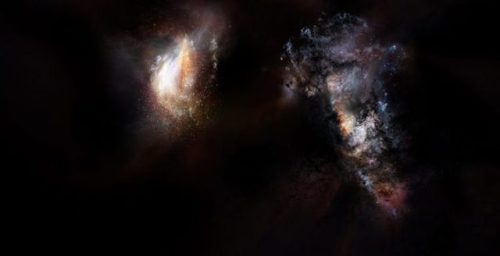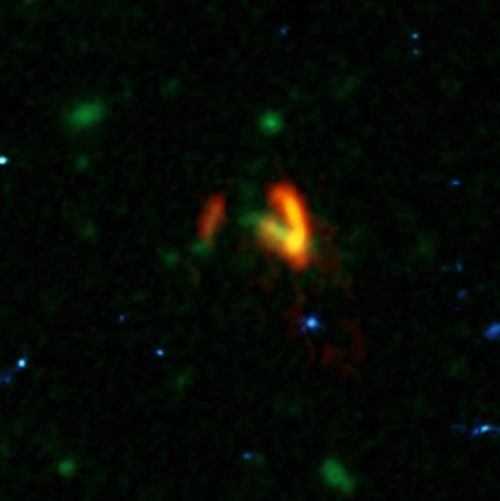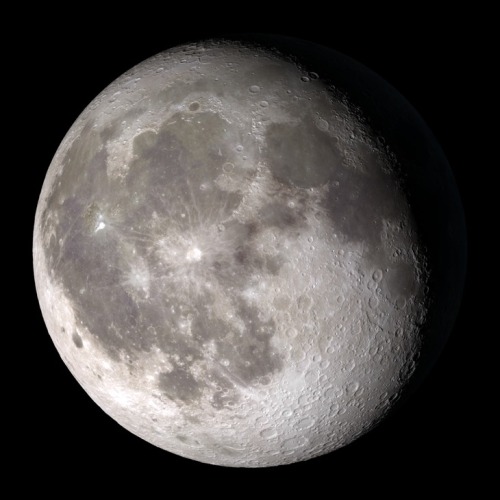Rosetta: “Comet From 8km”

Rosetta: “Comet from 8km”
Description A section of the smaller of Comet 67P/Churyumov–Gerasimenko’s two lobes as seen through Rosetta’s narrow-angle camera from a distance of about 8 km to the surface on 14 October 2014. The resolution is 15 cm/pixel. The image is featured on the cover of 23 January 2015 issue of the journal Science. More information: Getting to know Rosetta’s comet
Credit: ESA/Rosetta/MPS for OSIRIS Team MPS/UPD/LAM/IAA/SSO/INTA/UPM/DASP/IDA
More Posts from Starsglaxiesspace and Others


(NASA) Unexpected X-Rays from Perseus Galaxy Cluster
Image Credit: X-ray: NASA/CXO/Oxford University/J. Conlon et al.; Radio: NRAO/AUI/NSF/Univ. of Montreal/Gendron-Marsolais et al.; Optical: NASA/ESA/IoA/A. Fabian et al.; DSS
Why does the Perseus galaxy cluster shine so strangely in one specific color of X-rays? No one is sure, but a much-debated hypothesis holds that these X-rays are a clue to the long-sought identity of dark matter. At the center of this mystery is a 3.5 Kilo-electronvolt (KeV) X-ray color that appears to glow excessively only when regions well outside the cluster center are observed, whereas the area directly surrounding a likely central supermassive black hole is actually deficient in 3.5 KeV X-rays. One proposed resolution – quite controversial – is that something never seen before might be present: florescent dark matter (FDM). This form of particle dark matter might be able to absorb 3.5 KeV X-radiation. If operating, FDM, after absorption, might later emit these X-rays from all over the cluster, creating an emission line. However, when seen superposed in front of the central region surrounding the black hole, FDM’s absorption would be more prominent, creating an absorption line. Pictured, a composite image of the Perseus galaxy cluster shows visible and radio light in red, and X-ray light from the Earth-orbiting Chandra Observatory in blue.
Source


“More Giant Galaxies Discovered in the Early Universe”
Astronomers using the Atacama Large Millimeter/millimeter Array (ALMA) in Chile have discovered two giant galaxies that existed when the universe was only 780 million years old, or about 5 percent of its current age. These two galaxies, known collectively as SPTO311-58, appear to be within an even-more-massive dark matter halo, containing several trillion times the mass of our sun. This discovery is quite surprising for scientists. Like how suns and planets are formed from clumps of gas and rock sticking together, astronomers expected the first galaxies to resemble little dwarf galaxies such as those seen today. Yet, nature has surprised everybody, revealing examples of massive galaxies - even for today’s standards. The researchers wrote the following statement: “This ‘de-lensing’ process provided intriguing details about the galaxies, showing that the larger of the two is forming stars at a rate of 2,900 solar masses per year. It also contains about 270 billion times the mass of our sun in gas and nearly 3 billion times the mass of our sun in dust.” This shows that these galaxies very likely merged to eventually form the largest galaxy ever observed at that time period in cosmic history.
Read more about this fascinating story at: http://earthsky.org/space/primordial-galaxies-spt0311-58-dark-matter-early-universe
Images: Artist’s concept via NRAO/ AUI/ NSF; D. Berry. & Composite Image via ALMA (ESO/NAOJ/NRAO), Marrone, et al.; B. Saxton (NRAO/AUI/NSF); NASA/ESA Hubble.

Argyre Impact basin
Credits on photo

The Moon in Motion
Happy New Year! And happy supermoon! Tonight, the Moon will appear extra big and bright to welcome us into 2018 – about 6% bigger and 14% brighter than the average full Moon. And how do we know that? Well, each fall, our science visualizer Ernie Wright uses data from the Lunar Reconnaissance Orbiter (LRO) to render over a quarter of a million images of the Moon. He combines these images into an interactive visualization, Moon Phase and Libration, which depicts the Moon at every day and hour for the coming year.

Want to see what the Moon will look like on your birthday this year? Just put in the date, and even the hour (in Universal Time) you were born to see your birthday Moon.
Our Moon is quite dynamic. In addition to Moon phases, our Moon appears to get bigger and smaller throughout the year, and it wobbles! Or at least it looks that way to us on Earth. This wobbling is called libration, from the Latin for ‘balance scale’ (libra). Wright relies on LRO maps of the Moon and NASA orbit calculations to create the most accurate depiction of the 6 ways our Moon moves from our perspective.
1. Phases

The Moon phases we see on Earth are caused by the changing positions of the Earth and Moon relative to the Sun. The Sun always illuminates half of the Moon, but we see changing shapes as the Moon revolves around the Earth. Wright uses a software library called SPICE to calculate the position and orientation of the Moon and Earth at every moment of the year. With his visualization, you can input any day and time of the year and see what the Moon will look like!
2. Shape of the Moon

Check out that crater detail! The Moon is not a smooth sphere. It’s covered in mountains and valleys and thanks to LRO, we know the shape of the Moon better than any other celestial body in the universe. To get the most accurate depiction possible of where the sunlight falls on the lunar surface throughout the month, Wright uses the same graphics software used by Hollywood design studios, including Pixar, and a method called ‘raytracing’ to calculate the intricate patterns of light and shadow on the Moon’s surface, and he checks the accuracy of his renders against photographs of the Moon he takes through his own telescope.

3. Apparent Size

The Moon Phase and Libration visualization shows you the apparent size of the Moon. The Moon’s orbit is elliptical, instead of circular - so sometimes it is closer to the Earth and sometimes it is farther. You’ve probably heard the term “supermoon.” This describes a full Moon at or near perigee (the point when the Moon is closest to the Earth in its orbit). A supermoon can appear up to 14% bigger and brighter than a full Moon at apogee (the point when the Moon is farthest from the Earth in its orbit).
Our supermoon tonight is a full Moon very close to perigee, and will appear to be about 14% bigger than the July 27 full Moon, the smallest full Moon of 2018, occurring at apogee. Input those dates into the Moon Phase and Libration visualization to see this difference in apparent size!
4. East-West Libration
Over a month, the Moon appears to nod, twist, and roll. The east-west motion, called ‘libration in longitude’, is another effect of the Moon’s elliptical orbital path. As the Moon travels around the Earth, it goes faster or slower, depending on how close it is to the Earth. When the Moon gets close to the Earth, it speeds up thanks to an additional pull from Earth’s gravity. Then it slows down, when it’s farther from the Earth. While this speed in orbital motion changes, the rotational speed of the Moon stays constant.
This means that when the Moon moves faster around the Earth, the Moon itself doesn’t rotate quite enough to keep the same exact side facing us and we get to see a little more of the eastern side of the Moon. When the Moon moves more slowly around the Earth, its rotation gets a little ahead, and we see a bit more of its western side.
5. North-South Libration

The Moon also appears to nod, as if it were saying “yes,” a motion called ‘libration in latitude’. This is caused by the 5 degree tilt of the Moon’s orbit around the Earth. Sometimes the Moon is above the Earth’s northern hemisphere and sometimes it’s below the Earth’s southern hemisphere, and this lets us occasionally see slightly more of the northern or southern hemispheres of the Moon!
6. Axis Angle

Finally, the Moon appears to tilt back and forth like a metronome. The tilt of the Moon’s orbit contributes to this, but it’s mostly because of the 23.5 degree tilt of our own observing platform, the Earth. Imagine standing sideways on a ramp. Look left, and the ramp slopes up. Look right and the ramp slopes down.
Now look in front of you. The horizon will look higher on the right, lower on the left (try this by tilting your head left). But if you turn around, the horizon appears to tilt the opposite way (tilt your head to the right). The tilted platform of the Earth works the same way as we watch the Moon. Every two weeks we have to look in the opposite direction to see the Moon, and the ground beneath our feet is then tilted the opposite way as well.
So put this all together, and you get this:
Beautiful isn’t it? See if you can notice these phenomena when you observe the Moon. And keep coming back all year to check on the Moon’s changing appearance and help plan your observing sessions.
Follow @NASAMoon on Twitter to keep up with the latest lunar updates.
Make sure to follow us on Tumblr for your regular dose of space: http://nasa.tumblr.com.











SpaceTime 20171229 Series 20 Episode 100 is out today
SpaceTime covers the latest news in astronomy & space sciences.
The show is available as a free twice weekly podcast through Apple Podcasts (itunes), Stitcher, Pocketcasts, SoundCloud, Bitez.com, YouTube, Audio Boom, your favourite podcast download provider, and from www.spacetimewithstuartgary.com
SpaceTime is also broadcast coast to coast across the United States on Science360 Radio by the National Science Foundation in Washington D.C. around the world on Tune-In Radio and as inflight entertainment aboard Virgin Australia
SpaceTime daily news blog: http://spacetimewithstuartgary.tumblr.com/ SpaceTime facebook: www.facebook.com/spacetimewithstuartgary SpaceTime Instagram @spacetimewithstuartgary SpaceTime twitter feed @stuartgary
Today’s stories…
NASA looking at missions to a comet and to Saturn’s moon Titan NASA has selected two finalist concepts for a robotic mission planned to launch in the mid-2020s. The agency is considering a comet sample return mission and a drone-like rotorcraft that would explore potential landing sites on Saturn’s largest moon, Titan.
Was the star of Bethlehem a real thing? For astronomy the idea of three wise men being guided by a star to a stable in a little town called Bethlehem two thousand years ago raises a number of problems. But let’s for a moment just suppose it really happened – So, what star were they following?
ET’s not calling Scientists say they’ve detected no alien signals or any evidence of extraterrestrial technology coming from the strange cigar shaped interstellar visitor which speed through our solar system in September and October. The 400 metre long 40 metre wide asteroid designated A/2017 U1 and named Oumuamua the Hawaiian name meaning “messenger” or “scout"— has been the centre of astronomical attention ever since its unexpected detection.
Skywatch January We turn our eyes to the skies and check out the celestial sphere for January on Skywatch with the Quadrantids meteor shower to light up the skies as well as another super moon and total lunar eclipse.
SpaceTime Background SpaceTime is Australia’s most respected astronomy and space science news program. The show reports on the latest stories and discoveries making news in astronomy, astrophysics, cosmology, planetary science, galactic and stellar evolution, physics, spaceflight, and general science. SpaceTime features interviews with leading Australian scientists about their latest research. The show is broadcast coast to coast across the United States by the National Science Foundation on Science360 Radio, and is available in Australia as a twice weekly podcast which averages over 3.5 million downloads annually. It’s hosted through AudioBoom and Bitez.com on all major podcast platforms. SpaceTime is also available as inflight entertainment on Virgin Australia Airlines, and on Tune in Radio. The SpaceTime program began life in 1995 as ‘StarStuff’ on ABC NewsRadio. Stuart Gary created the show while he was NewsRadio’s evening anchor and Science Editor. Gary wrote, produced and hosted the program, consistently achieving 9 percent of the Australian national radio audience share, according to Neilsen ratings survey figures for the five main metro markets (Sydney, Melbourne, Brisbane, Adelaide, & Perth). The StarStuff podcast was hosted by ABC Science on line, achieving over 1.3 million downloads annually. StarStuff was axed in 2015 following ABC funding cuts. Gary resigned from the ABC, taking the show with him and rebranding it as SpaceTime. The first SpaceTime episode was broadcast on February 8th 2016 and the show has been in production twice weekly ever since.


-
 starsglaxiesspace reblogged this · 7 years ago
starsglaxiesspace reblogged this · 7 years ago -
 junainahkarim-blog liked this · 7 years ago
junainahkarim-blog liked this · 7 years ago -
 cloud--gazing reblogged this · 9 years ago
cloud--gazing reblogged this · 9 years ago -
 cloud--gazing liked this · 9 years ago
cloud--gazing liked this · 9 years ago -
 millennialtrance liked this · 10 years ago
millennialtrance liked this · 10 years ago -
 driffftttt reblogged this · 10 years ago
driffftttt reblogged this · 10 years ago -
 driffftttt liked this · 10 years ago
driffftttt liked this · 10 years ago -
 heliocentra liked this · 10 years ago
heliocentra liked this · 10 years ago -
 endo40k liked this · 10 years ago
endo40k liked this · 10 years ago -
 nopepperme liked this · 10 years ago
nopepperme liked this · 10 years ago -
 xxx-704-xxx liked this · 10 years ago
xxx-704-xxx liked this · 10 years ago -
 raukea-blog reblogged this · 10 years ago
raukea-blog reblogged this · 10 years ago -
 ancientoftimes liked this · 10 years ago
ancientoftimes liked this · 10 years ago -
 normalmadman-universe-blog1 liked this · 10 years ago
normalmadman-universe-blog1 liked this · 10 years ago -
 paradigmeshifter liked this · 10 years ago
paradigmeshifter liked this · 10 years ago -
 seapuzzle reblogged this · 10 years ago
seapuzzle reblogged this · 10 years ago -
 042lp reblogged this · 10 years ago
042lp reblogged this · 10 years ago -
 hamal4 reblogged this · 10 years ago
hamal4 reblogged this · 10 years ago -
 mindseesall reblogged this · 10 years ago
mindseesall reblogged this · 10 years ago -
 gods-on-the-run reblogged this · 10 years ago
gods-on-the-run reblogged this · 10 years ago -
 vaistinu reblogged this · 10 years ago
vaistinu reblogged this · 10 years ago -
 vaistinu liked this · 10 years ago
vaistinu liked this · 10 years ago -
 realm-9 liked this · 10 years ago
realm-9 liked this · 10 years ago -
 simpletrash reblogged this · 10 years ago
simpletrash reblogged this · 10 years ago -
 erughh reblogged this · 10 years ago
erughh reblogged this · 10 years ago -
 fizziemcguire-blog reblogged this · 10 years ago
fizziemcguire-blog reblogged this · 10 years ago -
 betontempel reblogged this · 10 years ago
betontempel reblogged this · 10 years ago -
 sunsetsheepman reblogged this · 10 years ago
sunsetsheepman reblogged this · 10 years ago -
 sunsetsheepman liked this · 10 years ago
sunsetsheepman liked this · 10 years ago -
 bababambi reblogged this · 10 years ago
bababambi reblogged this · 10 years ago -
 lovemetals liked this · 10 years ago
lovemetals liked this · 10 years ago -
 spaceforeurope reblogged this · 10 years ago
spaceforeurope reblogged this · 10 years ago -
 betontempel liked this · 10 years ago
betontempel liked this · 10 years ago -
 avatar-ophelia liked this · 10 years ago
avatar-ophelia liked this · 10 years ago -
 hforhood-blog reblogged this · 10 years ago
hforhood-blog reblogged this · 10 years ago -
 whirina liked this · 10 years ago
whirina liked this · 10 years ago -
 pingnova liked this · 10 years ago
pingnova liked this · 10 years ago